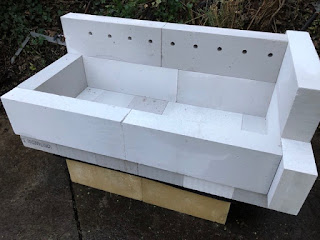If you read my recent(ish)
review of the year, you may have spotted that I've been chatting to some neighbours in Sydney Buildings who want to get started with beekeeping in the spring. We've met up a couple of times to discuss various things for when they get started. One of the options is which hive design to go for.
Regular readers will be aware that when I started beekeeping, I used the British National hive design. And that, a couple of years ago, I
converted my hives to the WBC design. Well, there are actually plenty of other hive designs around, including:
- The Commercial hive
- Langstroth hive
- Smith hive
- Dadant hive
- Dartington long hive
- Warre hive
- Top Bar hive
These are all wooden hives, but vary in the shape of the boxes, the way the honey frames are added (either sideways, or "upwards") and whether comb is built in frames or hangs from horizontal bars. But the Sydney Buildings group have decided to go for a different design entirely - they've picked the ZEST hive. But what is it?
Well, ZEST is a (sort-of) acronym for Zero Energy Sus-Tainable. Which doesn't tell you very much, although the creators of the hive have written about how they believe their design requires less intervention than traditional beekeeping, and has benefits for the bees in terms of their management of hive conditions (such as temperature and humidity) and
Varroa control.
But the really interesting thing about this hive is it contains hardly any wooden parts. Instead, the hive body is made from lightweight building blocks, and the frames are made of plastic. Also, the hive doesn't have any supers - instead, it works like a top-bar hive in that new frames are added at the ends, so the colony gets "longer" rather than "taller" as it expands.
Steve, from the Sydney Buildings group, has already built the first hive, which I must say took far less time than I took to build my first (National) hive. He kindly sent me some pictures of the build:
 |
| Building the base |
 |
| Starting the walls |
 |
| Walls complete |
 |
| The roof blocks go on |
Yes - that really is a beehive! Admittedly, it hasn't got the aesthetics of a Georgian (skep) or Victorian (WBC) hive - so apologies to the Bath Preservation Trust...! But if you're a fan of modernism/brutalism, then this could be right up your street.
I'm going to be working with the Sydney Buildings group throughout their first season, so there will be more updates to come. In the meantime, there's some more information on the ZEST hive at
www.thezesthive.com .







